![9 Best 70-inch TV In 2022 [Updated]](https://www.pctvguide.com/wp-content/uploads/2022/09/9-Best-70-inch-TV-In-2022-Updated.jpg)
The variety of options makes it difficult to choose the ideal TV for your living space. Today’s TV options generally offer similar content, with minor variations determined by personal preferences.
Shopping for a new TV can be a bit petty, from included streaming capabilities to a few inches in diagonal length. These distinctions add vibrancy to your home entertainment system and increase the excitement of the final purchase.
The best 70-inch TVs provide a huge amount of screen space without making your room look completely ridiculous.
We selected best 70-inch TVs include: VIZIO V-Series 4K HDR Smart TV, VIZIO M-Series QLED, Samsung Q90 QLED TV, Samsung 70-Inch BE70T-H Pro TV, Hisense ULED Premium U7G Quantum Dot QLED…
Please continue reading for more information.
Table of Contents
Best 70-inch TV
Best Overall: VIZIO V-Series 4K HDR Smart TV
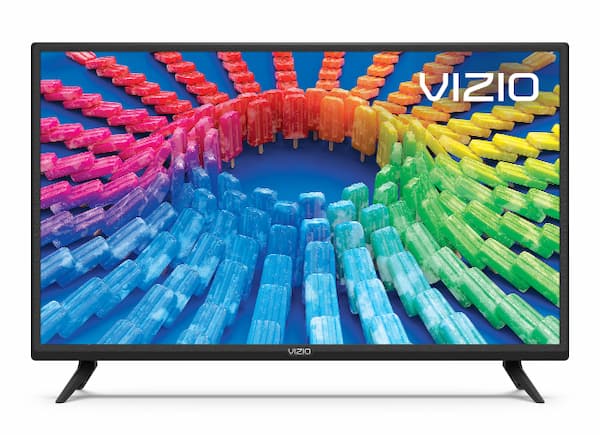
Pros
- Low input lag for gaming
- Affordable pricing
- Tons of picture options
Cons
- Basic sound
- Limited Smart TV options
In a competitive market, the VIZIO V-Series 4K HDR Smart TV represents a mid-level offering. Most people find it to be a good buy because of its reasonable price and features that they would expect from a TV.
When you don’t want to give your next TV much thought beyond size, you should purchase a VIZIO V-Series 4K HDR Smart TV. There are several different sizes available for this VIZIO TV line, all of which are functionally equivalent. It has reasonably accurate color right out of the box, but the built-in settings allow for a lot of customization if you want to fine-tune it.
Most buyers won’t be concerned about this TV’s flaws. The built-in speakers are adequate, but you ought to almost always use a soundbar or some other type of external audio anyhow. To connect all of your gaming systems, it has three HDMI ports. Sports and video games benefit from the low input lag by having a smoother image. It also adheres to the most widely used HDR standards.
No matter what you’re watching, the full-array LED backlight maintains a clear image. If you’re really committed to a 70-inch TV, this one will deliver a perfectly pleasant experience with just about any type of content you throw at it.
Best Thin Border Design: VIZIO M-Series QLED
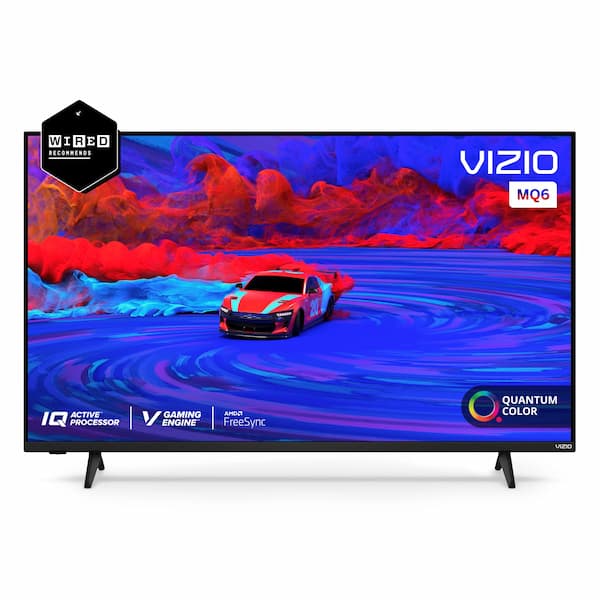
Pros
- High dynamic range
- Billions of colors
- Vizio SmartCast integration
- Thin frame design
- Great native contrast ratio
Cons
- Local dimming creates blooming
- Limited view angles
For playing video games and watching movies in a dimly lit room, consider the Vizio M-series TV. This TV is ideal for deep blacks due to its excellent native contrast ratio. When mounted on the wall, the TV has a respectable design and feels high-end.
To watch TV in full HDR with a wide color gamut, however, you must sit in front of the screen due to the limited view angles, which prevent you from watching TV from multiple angles. An excellent option for both indoor and outdoor use.
Best Samsung: Samsung Q90 QLED TV
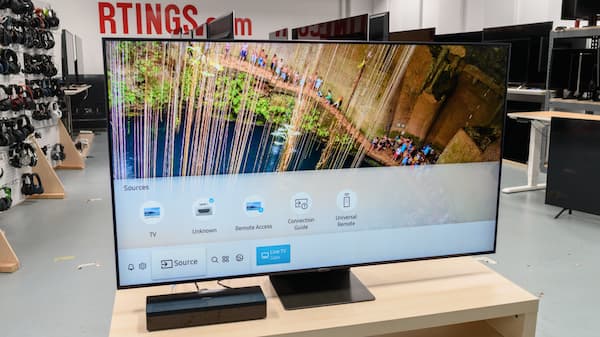
Pros
- Amazing sound for a UHD TV
- Sleek design
- Apple TV Exclusive partnership
Cons
- Expensive
- Standard HDMI 2.0 ports
One of the televisions with the best reviews is the Samsung Q90 QLED TV. Samsung QLEDs will look fantastic mounted on the wall and offer premium picture and sound quality that is almost unheard of with TVs this thin.
The Samsung Q90 QLED TV is essentially an OLED television, but the Q stands for “Quantum,” referring to Quantum Dot technology, which claims to provide better picture quality. With this TV, you get what you pay for. Although there isn’t a precise 70-inch version, the 65-inch and 75-inch models should sate your desire for clear, gorgeous images.
There are a few ways in which this TV is somewhat unique from other large-screen TVs. To start, Samsung kept the profile thin by forgoing embedded ports. Instead, the One Connect Box contains all ports and parts. A wire that is only partially transparent, known as an “Invisible Connection,” is used to connect that box. As a result, there is only one wire going to the console’s box, as opposed to a tangle of wires for each of your devices hanging from behind the TV.
Second, the sound is excellent for a flat, modern TV. Despite being only 1.6 inches thick, it contains a subwoofer and four speakers. Without having to connect an external soundbar, you get clear bass and audible speech.
Super sharp images, dark, and non-blinking highlights are produced by the Quantum Dot display. You won’t be able to tell that you aren’t looking out of a very well-lit window because of how well it handles HDR content. If you don’t mind stepping up to 75 inches or down to 65 inches, it’s a great all-around option.
Best Refresh Rate: Samsung 70-Inch BE70T-H Pro TV
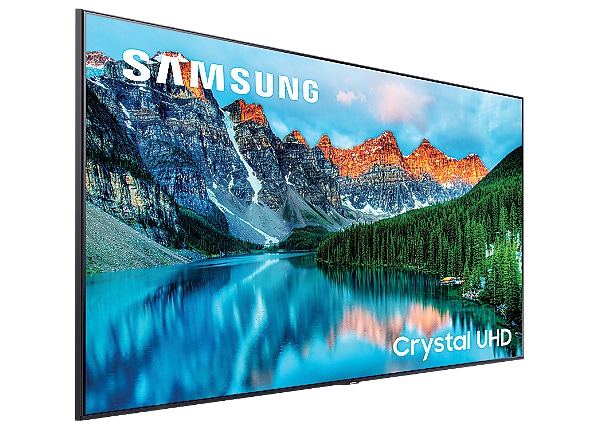
Pros
- Multiple input ports Compatible with
- Youtube and Samsung TV Plus
- Customizable Templates
- Control TV with the mobile phone app
- Automatic On/Off feature
Cons
- Non-smart TV
- Limited operating time
- Not good for home use
A UHD resolution display is provided by the TV’s lightning-fast Crystal 4K processor. This TV is ready to display accurate and smooth colors whether you plan to play high-graphic games or watch high-end display movies.
Although the TV has some great features, you are only allowed to watch for 16 hours a day in order to maintain the quality and dependability. Not bad, but this may disappoint you if you’re looking for a location where you have to watch TV constantly. so choose wisely considering the operating time duration.
Overall, the TV has a sophisticated design that makes it look expensive no matter where it is. However, if you’re looking for a home TV, this might be a good option right now. TV is a good option for any company to use for commercial purposes because it lacks some smart TV features and is designed with business purposes in mind.
For business advertisements, it’s simple to use thanks to the slide options and customizable user interface. It is among the best TVs under $1,000 thanks to its numerous input options.
Best For Gaming: Hisense ULED Premium U7G Quantum Dot QLED
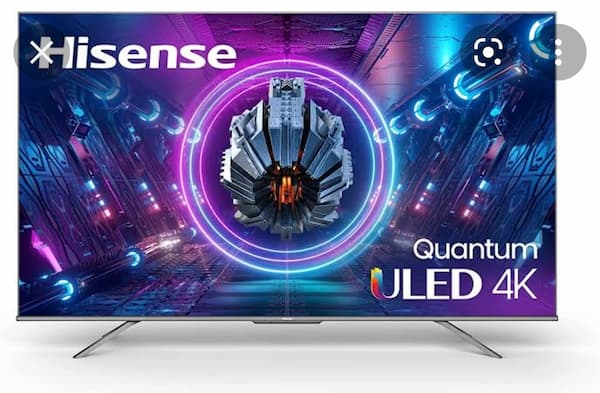
Pros
- Made for gaming
- Affordable
- QLED ULED high image quality
Cons
- Needs more HDMI 2.1 ports
- Passable audio
When it comes to gaming, the Hisense ULED Premium U7G Quantum Dot QLED TV checks all the right boxes, including HDMI 2.1 ports and low lag.
This TV is ideal for next-generation Xbox Series X or PS5 owners who don’t want to spend a lot of money. With Game Mode Pro, you can have the software recognize when you are playing games and instantly adjust the motion smoothing. Input lag, jittering, and broken frames are reduced to a minimum by FreeSync, variable refresh rate, and automatic low latency mode. While the Dolby Atmos sound does a passable job of delivering the sound, the 120Hz refresh rate keeps everything looking clear. Additionally, whereas standard HDMI 2.0 ports are unable to support high-resolution, high-framerate play, HDMI 2.1 ports can move enough data to enable it. (and don’t forget those HDMI cables.)
Voice controls and Google Assistant are also included with the U7G series’ operating system. They can be a little unreliable, like all voice controls on TVs (you’ll be yelling at your remote by the end of the night). However, they can help out in a pinch. The Hisense ULED Premium U7G Quantum Dot QLED TV is the best deal for gamers because of its sharpness, cost, and picture quality adjustments in the Game Mode Pro.
Best Budget: Hisense A6G Series LED 4K Android TV
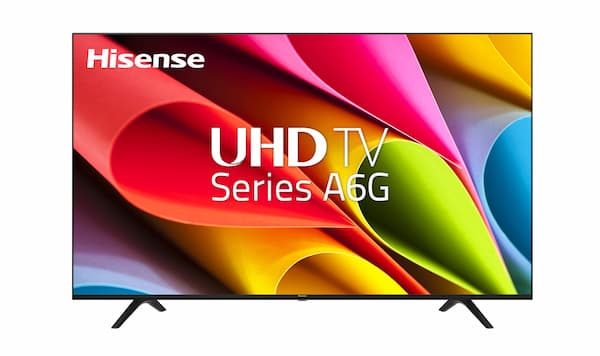
Pros
- HDMI 2.1 Compatibility
- Dolby Vision HDR
- Voice Control
Cons
- Backlight bleeds, which hurts contrast
Given its cost, the Hisense A6G Series LED 4K Android TV is a wise investment. You not only experience Android TV more fluidly than usual, but you also get a 70-inch 4K screen for less than $500.
You really can’t go wrong with the Hisense A6G Series LED 4K Android TV for a TV under $500. It offers a ton of features without raising the price. 70 inches of upscaled full HD content, the new HDR10+ standard for picture quality, the top-tier Dolby Vision HDR, and eARC HDMI output audio are all included. Because of its powerful quad-core processor, this TV is on par with models costing much more than it. Finding a justification for the low price of this television would be difficult.
The A6G Series comes pre-loaded with Android TV (at least in the US) rather than having its own smart TV option or Roku. You could always use your own streaming device as a backup if Android TV is known to be sluggish on some devices. Additionally, there are built-in voice controls for Amazon Alexa, as well as a sizable button on the remote for those who prefer to still press buttons.
Strong motion handling is one fantastic feature of this Hisense television series. The stability of the motion control offsets the contrast’s occasionally fuzziness. The Hisense A6G Series LED 4K Android TV is unique in the options it comes with for the price.
Best For Streaming Sports: LG UHD 70 Series
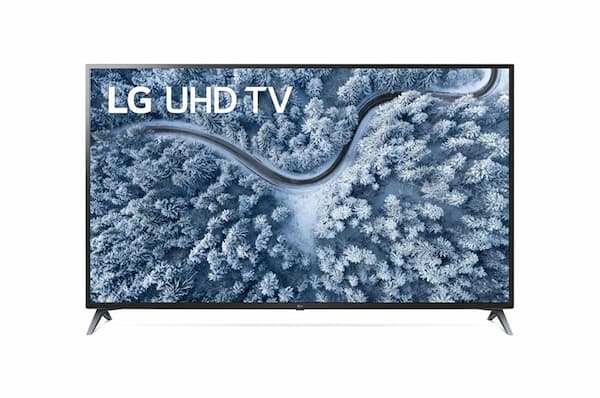
Pros
- Wide viewing angles
- Low input lag
- Good backlighting
Cons
- Weak contrast
- Struggles with HDR
Although the LG UHD 70 Series isn’t the best 70-inch TV on this list, it does have a few key features that make it ideal for watching sports content.
Wide viewing angles are the main factor in the LG UHD 70 Series’ placement on this list. This is a great overall experience for basic content consumption when combined with a strong backlight. It performs admirably with sports content, but not so well with HDR content. When you invite friends over to watch the big game, you can all see the screen clearly from anywhere in the living room thanks to the wider viewing angles.
Aside from that, the webOS operating system is serviceable but not exceptional. LG has had trouble with its Roku-like streaming content system in the past, but it makes up for it with support for Google Assistant, Alexa, and Apple AirPlay. It’s a good addition to have the low-latency gaming mode because it works well for watching sports. The LG UHD 70 Series is also among the more affordable models.
Best Honorable Mention: LG C9 Series 77” 4K UHD Smart OLED TV
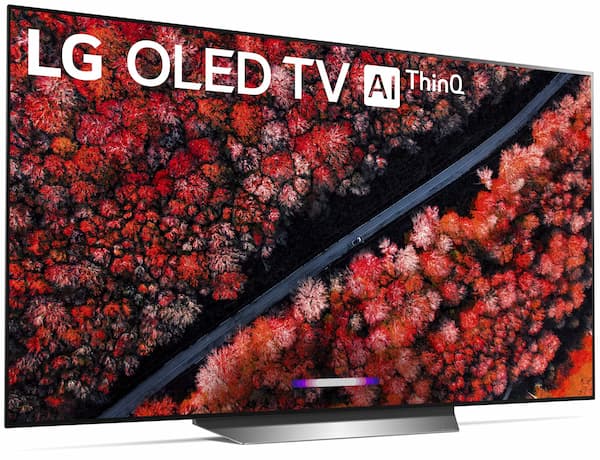
Pros
- Thinnest panel and great compatibility with entertainment apps
- Advanced image and sound technologies with ThinQ AI
- Lots of ports/inputs, like 4 HDMI, 3 USB, Ethernet, audio out/in, and more
Cons
- OLED screen burn-in is possible
- OLED displays are slightly dimmer than QLED panels
This TV integrates with a number of current platforms, including Google Assistant, Apply AirPlay, Alexa, and more. It runs the company’s WebOS operating system. One of the best and most versatile entertainment experiences are available right out of the box.
Thanks to the brand’s smart entertainment software, which is based on WebOS, this crazily thin panel comes with some of the best compatibility options built-in. Furthermore, it is this list’s top OLED TV. In a nutshell, it indicates that it works with many different platforms, including Google Assistant, Alexa, Apple AirPlay, Apple HomeKit, NVIDIA G-Sync, WiSA wireless audio, and others. Additionally, it has a wide range of inputs, including optical, coaxial, Ethernet, and AV-in standards, as well as 4 HDMI ports, 3 USB ports for multimedia, and others. It is prepared for mounting using VESA. Notably, this is also available in a 55-inch TV size.
The panel is visually stunning and has excellent image quality, two essential characteristics these days when selecting a smart TV. However, because it is OLED, it is less bright than some of the other panels, though many users will still find it to be adequate. The content displayed on screens with 4K UHD resolutions is distinct, crisp, and detailed. A more cinematic experience is provided by Dolby Vision HDR and Dolby Atmos 2.2 channel speakers. To display your TV, you might also need one of the best TV stands.
Best Roku Streaming Feature: TCL 5-Series
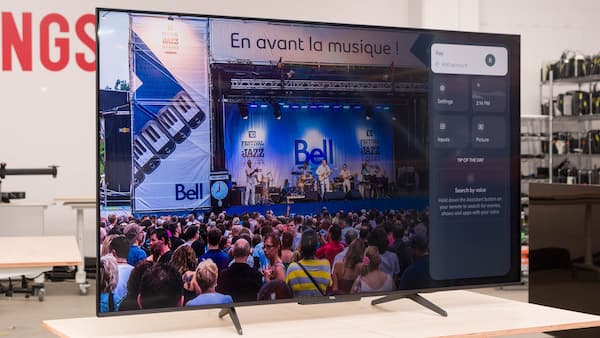
Pros
- Dolby Vision HDR display
- Low input lag
- Best TV for dark room
- Excellent contrast ratio
- Best TV for gaming
Cons
- Limited brightness
- No VRR support
- View angles are limited
When it comes to gaming and watching 4K movies, the TCL S535 is a fantastic option. This TV has an advantage over other TVs in this price range thanks to the excellent VA panel.
While being a fantastic option for watching the most recent movies and TV shows thanks to its smart TV functionality. It is a perfect piece to control from anywhere in the house thanks to the gaming features and voice control with Siri, Alexa, and Hey Google. overall total control over the television.
Last but not least, a large-screen, inexpensive TV may be the best option for motivating your loved ones.
How To Select The Best 70-inch TVs?
Check out our TV Buying Guide’s recommendations when looking for a 70-inch TV. You’ll be able to benefit from your purchase for many years if you give some thought to what you need from a TV.
Size
Determine first if you are forced to purchase a 70-inch model. With more features and occasionally a better price, 65- and 75-inch models offer more options.
Sound
We still advise upgrading your television’s sound system even though it might seem like a waste of money. Even though a top-notch UHD 4K Smart TV will undoubtedly provide fantastic image quality, built-in speakers cannot ensure the same sound quality as an upscale high-quality surround sound system. If the audio doesn’t surround you and give you an immersive experience, how can you watch your favorite TV show? In addition, be sure to look at all the new updated ports that are included with contemporary TVs. An optical digital audio cable has taken the place of the aux cable (jack cable) in some televisions.
Control
Don’t forget to look at the TV’s included remote control. Smart remote controls come with built-in microphones for voice recognition, wand-like controls for the screen, and other practical features. Additionally, some TVs come with Motion Control, which enables you to easily switch between channels or volume levels, swipe through and use apps, or use two-handed gestures to zoom in and out of images, just like on a smartphone or tablet.
Price
Most 70-inch TVs should cost between $650 and $700, though those with better features or a well-known brand name may cost more.
Features
Consider the number and type of ports you require. How many devices, such as a streaming stick, gaming console, or cable box, you intend to plug in will determine how many HDMI ports you need. While the Samsung TU7000 only has two HDMI inputs, the majority of these TVs have three. An optical digital audio or 3.5 mm auxiliary output might be required if you intend to use a soundbar. Additionally, you might want a TV that works with Bluetooth so you can use headphones to listen to music without disturbing others.
Included Smart TV Options
We no longer actively subscribe to cable as a population. not in the conventional sense, at least. But because we subscribe to so many streaming services, a streaming service aggregation app is practically required when buying a new TV. This explains why so many recent TVs are referred to as “smart TVs.”” Typically, they have an operating system that is tailored specifically for streaming apps, like Roku. Some smart TVs come with pre-installed apps or have their own aggregation service (much like a mobile app store). It’s uncommon for a new TV to lack smart features, but a few models do not have this useful component.
Backlight Tech
TVs require light to display the image, and different models use different techniques to generate that light. In a typical TV, an image is produced by LEDs that shine through the LCD panel. Quantum dots, which stack on the LEDs to emit light when excited and produce a brighter, punchier image, are added to QLED TVs, which use a similar technology. Although they lack overall brightness, OLED TVs have the advantage of being able to completely black out portions of the screen to produce striking contrast. Some more recent TV models use Micro-LED or even Mini-LED as their backlight. The best of both worlds in terms of brightness and contrast are offered by those new products, which produce light using a massive array of tiny LEDs.
Resolution
A 8K TV is not necessary. At the same time, 1080p TVs are typically only available at the low end of the market and are largely no longer relevant. 4K is the resolution you want at the moment. Typically, that refers to a display with a resolution of 3840 x 2160. Even if you don’t regularly watch Blu-rays or have a current-generation gaming console, 4K TVs will upscale your content to fit its pixel-hungry display.
Refresh Rate
TVs need to make the image on the screen appear to be moving, and they accomplish this by refreshing the image several times per second. The on-screen motion appears smoother the more times per second it refreshes. While most TVs refresh 60 times per second, more expensive TVs offer refresh rates up to 120Hz. Variable refresh rate technology, which is supported by some more recent high-end models, guarantees that the image displayed matches the source’s output precisely to avoid image tearing and other negative effects. If you watch a lot of sports or play a lot of video games where the smooth motion looks natural, higher refresh rates come in handy. However, if you mainly watch TV and movies, that additional refresh rate won’t enhance your overall viewing experience.
Check out our selections for the top TVs in each category if you’ve limited your search for a TV by brand, price range, or screen size.
Why You Should Purchase A New 70-inch TV?
If you’re trying to decide whether to buy a 70- or 75-inch TV, you must first determine whether this behemoth will fit in the space you have. For a comfortable viewing distance on a 70-inch 4K TV, you’ll need to have your main seating area at least 10 feet away from the screen. Additionally, with a TV this nice, you can watch even the best HDR content in the comfort of your own home.
Furthermore, remember that a ten years ago, a 40-inch flat-screen TV would have cost you at least $1,500. Since a 70-inch screen can now be purchased for that price, many more consumers can now afford large TV screens, making the 70-inch model worthwhile to take into consideration.
And if you enjoy Blu-ray movies or have plans to switch to 4K television programming as soon as it becomes available from your cable or satellite provider, now might be a good time to invest in a sizable 4K 70-inch model so you’ll be prepared for the transition to 4K for the best premium viewing experience. Additionally, since 4K is only now beginning to gain popularity and a wide range of content is becoming available, your television will be more useful with 4K compatibility. Furthermore, it’s even better if your TV supports Dolby Vision. The 10,000 Nits of brightness provided by Dolby Vision cannot be handled by the TVs currently on the market. The situation will probably change as TVS updates. The 70-inch and larger TVs on our list don’t necessarily look as good as they do because of the 4K resolution, though: These screens are of high quality due to their quick refresh rates, higher contrast ratios, and local dimming options that produce deep blacks. Again, it’s critical to have these technologies accessible for such enormous screens because any flaw is much more obvious on such a large screen than it is on a screen that is average in size or smaller. In general, if you stick to our advice, you won’t regret getting one of these 70-inch TVs.
What Else Should You Ponder?
If you’re on the fence about getting such a big TV, check out our list of the best home theater projectors, which start at $700 and go up to $2,300. If you choose to go in this direction, you’ll need a screen or projection space you can use, and some projectors don’t have a bright enough output to be clearly visible in a room with windows and sunlight, but home theater projectors are a practical substitute for the hefty 70-inch or larger television.
Although it seems kind of silly to consider, the biggest drawback to selecting the best 70 inch TV is the model being too big for the space you have available. I can’t stress enough how disappointed you’ll be in the quality of your television viewing if you put a TV that’s larger than 70 inches in a room where your main sitting area is closer than 8 feet away from it. No matter whether you have great picture quality, clever features, a game mode, wider viewing angles or a narrow viewing angle, the viewing experience won’t be ideal if the right distance isn’t established. Imagine yourself in the front row of a movie theater, where the enormous screen almost makes you queasy. You can use our TV buying guide to determine whether a big screen will fit comfortably in your available space.
I wouldn’t suggest anything other than a 4K screen resolution for a 70-inch or larger TV because it will provide four times as many pixels as an HD screen resolution model. You should also consider the number of HDMI ports the television has when looking for great smart TV features. A smartTV that prioritizes Dolby Vision as one of its features might be something to take into consideration if you’re searching for the best of the best.
The power cord is the last component, which is frequently disregarded. The power cable is an essential component, depending on whether you intend to mount your TV on the wall or comfortably place it on a stand. If it’s too short, it will be difficult for you to reach the plug socket. If you take too much time, you’ll end up fumbling around while attempting to conceal the cable.
FAQs
Which 70-inch TV Under $1,000 Is The Best?
Our top pick for the best 70-inch TV under $1,000 is the VIZIO 70-Inch M-Series 4K QLED HDR Smart TV. The TV costs about $800 and offers a ton of special features.
TV was my favorite item; it’s ideal for both domestic and business use. The large screen, which features a 4K display, is beneficial for gaming. Any streaming device, like Roku or Firestick, can be connected to it using HDMI ports.
What Manufacturer Produces 70-inch TVs That Are More Dependable?
One of the most dependable companies that produces high-quality 70-inch TVs on a budget is SAMSUNG. The Samsung TV is suitable for both residential and commercial use. Additionally, they include a limited warranty and a user manual for the TV.
Why Are There So Few 70-inch Tvs Available?
Larger TV sets are less common for a variety of factors. The fact that they cost a lot to make and not every brand or manufacturer has access to the necessary technology is the most important. For instance, Samsung has a long history of producing its own, incredibly vivid panels and displays, even for mobile devices. There are sets available with TV sizes ranging from 70 to 75 inches to 90 inches and higher.
Which Is Superior, Oled Or Qled?
The average person cannot tell the difference. Each type of panel has a different quality and user experience, and some brands excel at a certain technology more than others. Because OLED has a faster refresh rate and better movement handling, it is frequently lighter, thinner, and sharper. The sizes and dimensions of OLED panels are, regrettably, frequently more limited. If you’re used to extremely bright and clear displays, the brightness can also be reduced. Furthermore, as OLED panels age, burn-in tends to occur more frequently. In contrast, QLED has exceptionally bright and accurate whites and is extremely bright. They typically have thicker, less svelte bodies and slower refresh rates. However, they also come in a wide range of sizes, including ones that are considerably larger than the 80″ limit for OLED, at least at this time. While Samsung is the leader in QLED technology, Sony and LG typically offer OLED displays. From many of the same brands, you can also find a standard LCD TV with LCD panels.
How Far Away Should You Place A 70-inch Tv?
The ideal viewing distance for a 70″ 4K TV is between 7 and 11 feet. That provides an excellent viewing angle and a sharp, vivid image.
What Is Quantum Dot Technology?
A quantum dot is a nanoparticle created by humans with semiconductor properties. In order to illuminate a Liquid Crystal Display (LCD) screen, an LED backlight is typically used in conjunction with a sheet of film that has been coated with quantum dots. Super Ultra High Definition, or SUHD, is a term that Samsung first used a few years ago.” In reality, Quantum Dot panel technology simply improves contrast, color depth, and black depth while maintaining the same 4K UHD resolution.
What Is True Color?
The specification of a pixel’s color on a display screen using a 24-bit value, which allows for the possibility of up to 16,777,216 different colors, is known as True Color Technology (also known as 24-bit color). The bit-depth of a pixel refers to how many bits are used to specify the color shade. Every panel will be delivered by True Colors with the highest level of accuracy in color precision.
The End
The 70-inch TV that best suits your needs will also be the one that is more dependable; the newest features should be found in the TV.
Without a remote control, smart TVs can be operated from anywhere in your home. Making a wise choice between the most recent models is therefore preferable.
With that said, make a wise decision based on your requirements and spending capacity. I did my best to help you understand why TV might be the best option. So, the decision is now up to you!
We appreciate you reading.

